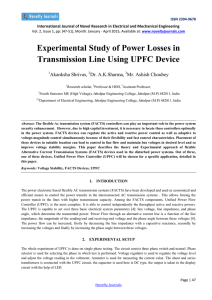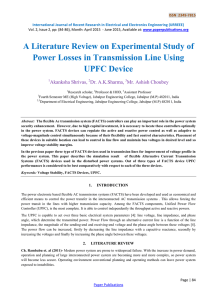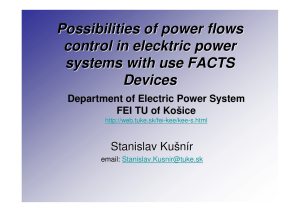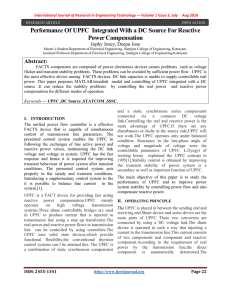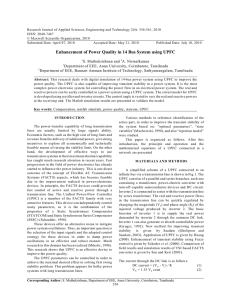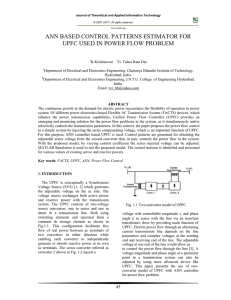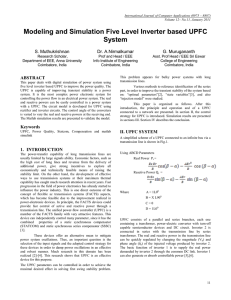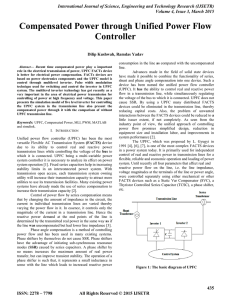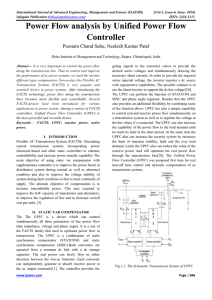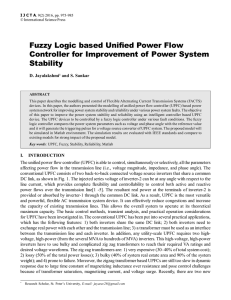view full paper - International Journal of Scientific and Research
advertisement
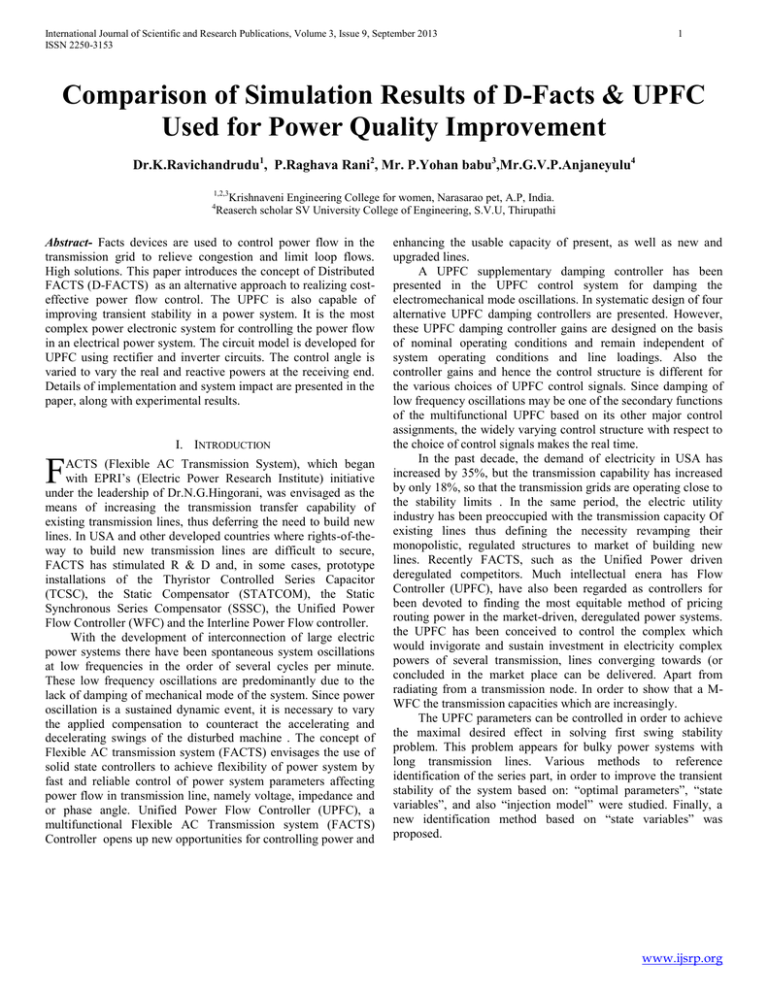
International Journal of Scientific and Research Publications, Volume 3, Issue 9, September 2013 ISSN 2250-3153 1 Comparison of Simulation Results of D-Facts & UPFC Used for Power Quality Improvement Dr.K.Ravichandrudu1, P.Raghava Rani2, Mr. P.Yohan babu3,Mr.G.V.P.Anjaneyulu4 1,2,3 Krishnaveni Engineering College for women, Narasarao pet, A.P, India. Reaserch scholar SV University College of Engineering, S.V.U, Thirupathi 4 Abstract- Facts devices are used to control power flow in the transmission grid to relieve congestion and limit loop flows. High solutions. This paper introduces the concept of Distributed FACTS (D-FACTS) as an alternative approach to realizing costeffective power flow control. The UPFC is also capable of improving transient stability in a power system. It is the most complex power electronic system for controlling the power flow in an electrical power system. The circuit model is developed for UPFC using rectifier and inverter circuits. The control angle is varied to vary the real and reactive powers at the receiving end. Details of implementation and system impact are presented in the paper, along with experimental results. I. INTRODUCTION F ACTS (Flexible AC Transmission System), which began with EPRI’s (Electric Power Research Institute) initiative under the leadership of Dr.N.G.Hingorani, was envisaged as the means of increasing the transmission transfer capability of existing transmission lines, thus deferring the need to build new lines. In USA and other developed countries where rights-of-theway to build new transmission lines are difficult to secure, FACTS has stimulated R & D and, in some cases, prototype installations of the Thyristor Controlled Series Capacitor (TCSC), the Static Compensator (STATCOM), the Static Synchronous Series Compensator (SSSC), the Unified Power Flow Controller (WFC) and the Interline Power Flow controller. With the development of interconnection of large electric power systems there have been spontaneous system oscillations at low frequencies in the order of several cycles per minute. These low frequency oscillations are predominantly due to the lack of damping of mechanical mode of the system. Since power oscillation is a sustained dynamic event, it is necessary to vary the applied compensation to counteract the accelerating and decelerating swings of the disturbed machine . The concept of Flexible AC transmission system (FACTS) envisages the use of solid state controllers to achieve flexibility of power system by fast and reliable control of power system parameters affecting power flow in transmission line, namely voltage, impedance and or phase angle. Unified Power Flow Controller (UPFC), a multifunctional Flexible AC Transmission system (FACTS) Controller opens up new opportunities for controlling power and enhancing the usable capacity of present, as well as new and upgraded lines. A UPFC supplementary damping controller has been presented in the UPFC control system for damping the electromechanical mode oscillations. In systematic design of four alternative UPFC damping controllers are presented. However, these UPFC damping controller gains are designed on the basis of nominal operating conditions and remain independent of system operating conditions and line loadings. Also the controller gains and hence the control structure is different for the various choices of UPFC control signals. Since damping of low frequency oscillations may be one of the secondary functions of the multifunctional UPFC based on its other major control assignments, the widely varying control structure with respect to the choice of control signals makes the real time. In the past decade, the demand of electricity in USA has increased by 35%, but the transmission capability has increased by only 18%, so that the transmission grids are operating close to the stability limits . In the same period, the electric utility industry has been preoccupied with the transmission capacity Of existing lines thus defining the necessity revamping their monopolistic, regulated structures to market of building new lines. Recently FACTS, such as the Unified Power driven deregulated competitors. Much intellectual enera has Flow Controller (UPFC), have also been regarded as controllers for been devoted to finding the most equitable method of pricing routing power in the market-driven, deregulated power systems. the UPFC has been conceived to control the complex which would invigorate and sustain investment in electricity complex powers of several transmission, lines converging towards (or concluded in the market place can be delivered. Apart from radiating from a transmission node. In order to show that a MWFC the transmission capacities which are increasingly. The UPFC parameters can be controlled in order to achieve the maximal desired effect in solving first swing stability problem. This problem appears for bulky power systems with long transmission lines. Various methods to reference identification of the series part, in order to improve the transient stability of the system based on: “optimal parameters”, “state variables”, and also “injection model” were studied. Finally, a new identification method based on “state variables” was proposed. www.ijsrp.org International Journal of Scientific and Research Publications, Volume 3, Issue 9, September 2013 ISSN 2250-3153 2 Fig 1. single line dig of UPFC. II. UPFC SYSTEM A simplified scheme of a UPFC connected to an infinite bus via a transmission line is shown in Fig.1. UPFC consists of parallel and series branches, each one containing a transformer, power-electric converter with turn-off capable semiconductor devices and DC circuit. Inverter 2 is connected in series with the transmission line by series transformer. The real and reactive power in the transmission line can be quickly regulated by changing the magnitude (Vb) and phase angle (δb) of the injected voltage produced by inverter 2. The basic function of inverter 1 is to supply the real power demanded by inverter 2 through the common DC link. Inverter 1 can also generate or absorb controllable power. New method for improving transient stability is given in. Application of UPFC in interconnected power system by presented in. Enhancing transient stability using Fuzzy control is given in. Comparison of field results and simulation results of VSI based facts controller is given in Fig. 1 shows the single-line diagram of buses A: B and C which are extracted from a larger system. The buses are joined by transmission h e s represented by line reactances jX B and jXc . In the absence of the M-UPFC, the real power transferred from bus A through the lines are V2 sin(δA- δB)/XB and V2 sin(δAδC)&, where V is the line voltage, δA, δB & δC are the voltage angles of the buses. As buses B and C are connected to the remainder of the large interconnected system (not shown), the angles δB and δB play their roles also in determining the real power transfers in other parts of the larger system. When the electricity supplier is contracted to sell powers PA and P B to bus A and B respectively, then PA=V2Sin (δA- δB)/XB, and PB= V2Sin (δA- δC)/XB, must be satisfied simultaneously. This would require the co-operation and co-ordination of the entire power grid to adjust δB, δC and with respect to δA. In -adjusting δB and δC, desirably there should be no degradation of the power transmission transfer capability elsewhere. IV. SIMULATION RESULTS III. SPECIFICITY OF POWER FLOWS IN ENERGY TRANSACTIONS Hingorani and Stahlkopf mentioned loop flow (in which currents flow along unintended paths) as one kind of degradation of transmission capacity. They gave an simp1e of hydroelectric power from Ontario intended for the air conditioners of New York City straying as far west as Ohio and Kentucky. This detour would be costly to Ohio and Kentucky, as in carrying the unwanted power, the transmission transfer capability of their h e s was consumed so that there would be little left to serve their own customers. This example was taken from the pre deregulation era. If FACTS Controllers were deemed desirable in the prederegulation era: how much more would they be necessary in the post deregulation era, as pure pricing mechanism can operate only when the laws of electricity are surmounted by FACTS Controllers such as the UPFC. A simple example is used to illustrate this. Two bus system without compensation is shown in Fig 2a. Sag is produced when an additional load is added. Voltage across loads 1 and 2 are shown in Fig 2b. The real power and reactive power waveforms are shown in Figures 2c and 2d respectively. Two bus system with UPFC is shown in Fig 3a. UPFC is represented as a subsystem. The details of subsystem are shown in Fig 3a. Voltage across loads 1 and 2 are shown in Fig 3a. Real and reactive powers are shown in Figs 3d and 3e respectively. UPFC using voltage and current sources are shown in Fig4a. Converter 1 is represented as a shunt current source and converter 2 is represented as a series voltage source. Load voltage and current waveforms are shown in Fig 2b. Real and reactive powers are shown in Fig 2c. Variation of powers with the variation in the angle is given in table 1. The real and reactive powers increase with the increase in the angle of voltage injection. www.ijsrp.org International Journal of Scientific and Research Publications, Volume 3, Issue 9, September 2013 ISSN 2250-3153 3 Fig 2. Compensation With out upfc Fig. 2c. Real Power Fig. 2d. Reactive Power Fig. 2b. Voltage Across Load 2 and Load 1 www.ijsrp.org International Journal of Scientific and Research Publications, Volume 3, Issue 9, September 2013 ISSN 2250-3153 4 Fig.3 Compensation With out upfc Fig.4. Series & shunt compensation fact (upfc) Fig. 3c. Voltage across Load 2 and Load V. CONCLUSION In the simulation study, mat lab simulink environment is used to simulate the model of UPFC connected to a 3 phase system. In this paper, the simulation results of switching level modeling of UPFC using IGBT developed in MATLAB/SIMULINK have been presented. The linear firing angle and sinusoidal pulse width modulation have been proposed as the switching schemes for shunt & series converters. These switching schemes have been. This paper presents the control & performance of the UPFC used for power quality improvement. Voltage compensation using UPFC is studied. The real and reactive powers increase with the increase in angle of injection. Simulation results show the effectiveness of UPFC to control the real and reactive powers. The simulation result proves that the UPFC with the proposed switching schemes functions successfully as the real time power flow controller. This controller improves the performance of transient and dynamic www.ijsrp.org International Journal of Scientific and Research Publications, Volume 3, Issue 9, September 2013 ISSN 2250-3153 stability and achieves good damping of power and voltage oscillations in the system. [7] [8] REFERENCES [1] [2] [3] [4] [5] [6] L. Gyugyi, C. D. Schauder, S. L. Williams, T. R. Reitman, D. R. Torgerson, and A. Edris, “The unified power flow controller: A new approach to power transmission control,” IEEE Trans. Power Delivery, vol. 10, pp. 1085– 1097, Apr. 1995. C. D. Schauder, L. Gyugyi, M. R. Lund, D. M. Hamai, T. R. Rietman, D. R. Torgerson, and A. Edris, “Operation of the unified power flow controller (UPFC) under practical constraints,” IEEE Trans. Power Delivery, vol. 13, pp. 630–636, Apr. 1998. K. K. Sen and E. J. Stacey, “UPFC-UnifiedPower flow controller: Theory, modeling, and applications,” IEEE Trans. Power Delivery, vol. 13, pp. 1453–1460, Oct. 1999. B. A. Renz, A. S. Mehraben, C. Schauder, E. Stacey, L. Kovalsky, L. Gyugyi, and A. Edris, “AEP unified power flow controller performance,” IEEE Trans. Power Delivery, vol. 14, pp. 1374–1381, Oct. 1999. P. K. Dash, S. Mishra, and G. Panda, “A radial basis function neural netwrok controller for UPFC,” IEEE Trans. Power Syst., vol. 15, pp. 1293– 1299, Nov. 2000. “Damping multimodal power system oscillation using a hybrid fuzzy controller for series connected FACTS devices,” IEEE Trans. Power Syst, vol. 15, pp. 1360–1366, Nov. 2000. [9] 5 E. Gholipour and S.Saadate, “ A new method for improving transient stability of power systems by using UPFC,” in Proc. European Power Electronics, Toulouse, France, Sep. 2003. Z. Huang et al.,”Application of UPFC in interconnected power systemsModeling, interface, control strategy, and case study, “ IEEE Trans. Power Syst., vol. 15, no. 2, pp. 817-824, May 2000. K. Schoder, A, hasanovic, and A. feliachi, “ Enhancing transient stability using fuzzy control scheme for the unified power flow controller (UPFC) within the power system toolbox (PST). AUTHORS First Author – Dr.K.Ravichandrudu, Krishnaveni Engineering College for women, Narasarao pet, A.P, India. Second Author – P.Raghava Rani, Krishnaveni Engineering College for women, Narasarao pet, A.P, India. Third Author – Mr. P.Yohan babu, Krishnaveni Engineering College for women, Narasarao pet, A.P, India. Fourth Author – Mr.G.V.P.Anjaneyulu, Reaserch scholar SV University College of Engineering, S.V.U, Thirupathi www.ijsrp.org
